________________
Western Indian Jaina Temple: Generalities
(3) Mūlaprāsāda
Prāsāda or shrine is called 'mūlaprāsāda' or 'principal shrine' by virtue of its being the sanctuary proper in relation to the surrounding devakulikās or subsid shrines. The main cella, moreover, enshrines the 'mūlanāyaka'or the cult image of the Jina which is also called the ‘adhināyaka'— 'Image Superior' or 'Principal Image'-in relation to the images of other Jinas enshrined in the smaller or subsidiary shrines within the complex. In plan and elevation the mūlaprāsāda in no way differs from the Brahmanical building from the standpoint of architectural elevation. It is the associated iconographical program which sets it apart from a Brahmanical sacred edifice. For instance, the narapītha-belt in the base mouldings may show the narrative portrayal of the ‘pañcakalyāṇakas', the five auspicious events in the life of a Jina, in lieu of the Brahmanical puranic and related episodes. Also, the faces of the kumbha moulding of the vedibandha, when it displays miniature niches containing figural carving (in lieu of the usual half diamond and/or half lotus ubiquitously seen on a Maru-Gurjara temple), shows the seated images of Vidyādevīs, Yakşīs, Sarasvatī, and at times a few other Jaina divinities of the Yakṣa category like Brahmaśānti and Gomukha. While the karnas (anglebuttresses) carry framed images of the Dikpālas as is the case with the Brahmanical temples, the neighbouring pratirathas show Yakşīs, Vidyādevīs etc., in lieu of the surasundarī figures invariably met with on the flanking buttresses of the Brahmanical temples. Moreover, the bhadra-niches at the cardinals of the sanctuary walls shelter seated (sometimes standing) Jina figures in lieu of the Brahmanical divinities. This is also true of the bhadra-rathikās (framed niches) applied/inserted at cardinal points of the lower end of the sikhara where either Jina images or, more frequently indeed the attendant Jaina divinity figures— Yaksīs, Vidyādevīs etcetera—are shown. In Kumbhāriyā, only the Neminātha temple has a fully moulded and decorated base and wall for its prāsāda. However, while the śikharas of all other Jaina temples here show the jāla or the so-called 'beehive pattern', the Neminātha temple has a lately done śikhara which is devoid of it. All the śikharas here are of the Anekāndaka or Sekharī (multi-turreted) class, the Latina (monospired) type went out of vogue after early 11th century.
(4) Gūdhamandapa
The closed hall, conjoined with the prāsāda with the help of the 'kapili' or connecting vestibular pair of parallel walls, is the immediate adjunct within which the devotees
Jain Education International
For Private & Personal Use Only
www.jainelibrary.org




